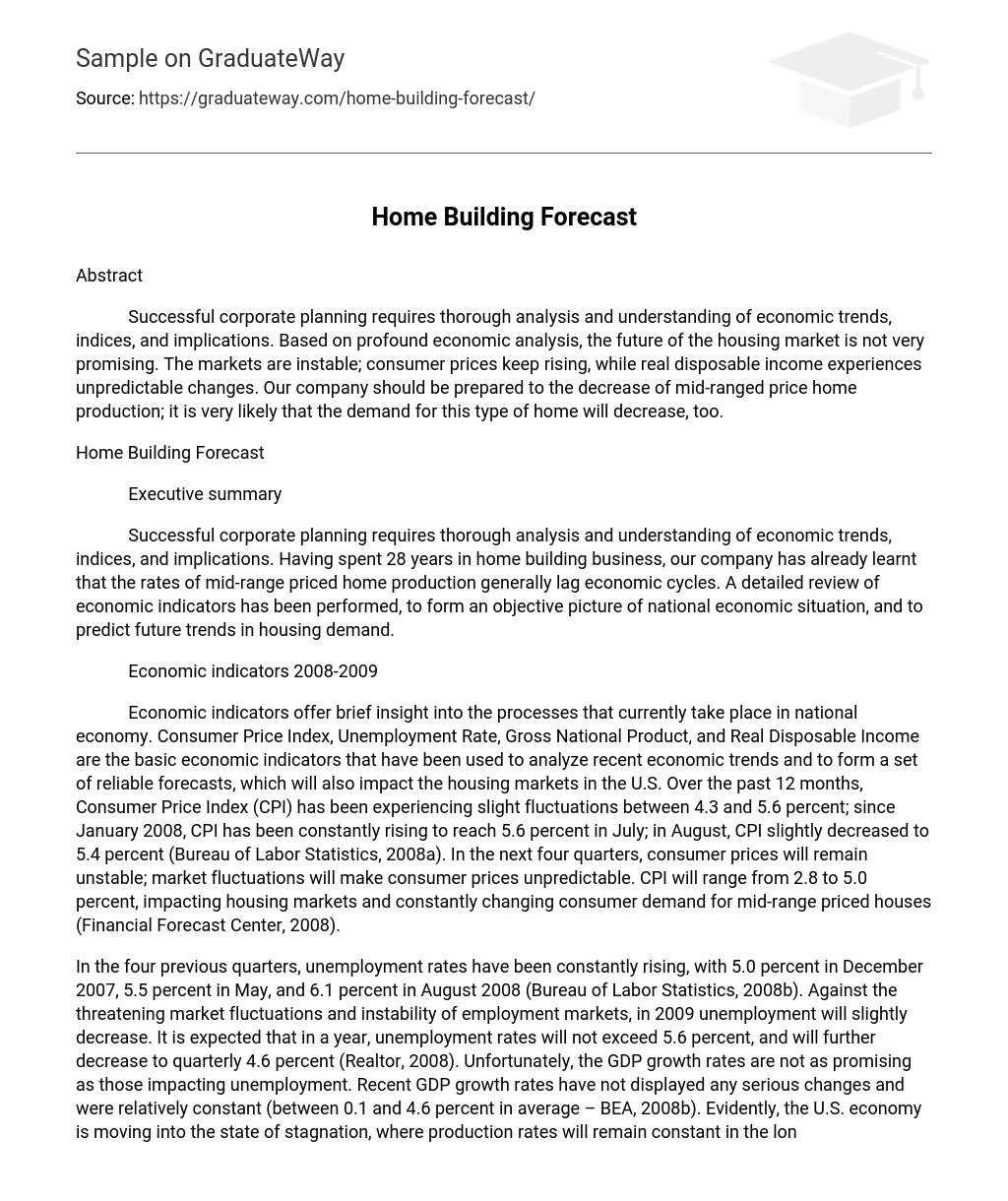Abstract
Successful corporate planning requires thorough analysis and understanding of economic trends, indices, and implications. Based on profound economic analysis, the future of the housing market is not very promising. The markets are instable; consumer prices keep rising, while real disposable income experiences unpredictable changes. Our company should be prepared to the decrease of mid-ranged price home production; it is very likely that the demand for this type of home will decrease, too.
Home Building Forecast
Executive summary
Successful corporate planning requires thorough analysis and understanding of economic trends, indices, and implications. Having spent 28 years in home building business, our company has already learnt that the rates of mid-range priced home production generally lag economic cycles. A detailed review of economic indicators has been performed, to form an objective picture of national economic situation, and to predict future trends in housing demand.
Economic indicators 2008-2009
Economic indicators offer brief insight into the processes that currently take place in national economy. Consumer Price Index, Unemployment Rate, Gross National Product, and Real Disposable Income are the basic economic indicators that have been used to analyze recent economic trends and to form a set of reliable forecasts, which will also impact the housing markets in the U.S. Over the past 12 months, Consumer Price Index (CPI) has been experiencing slight fluctuations between 4.3 and 5.6 percent; since January 2008, CPI has been constantly rising to reach 5.6 percent in July; in August, CPI slightly decreased to 5.4 percent (Bureau of Labor Statistics, 2008a). In the next four quarters, consumer prices will remain unstable; market fluctuations will make consumer prices unpredictable. CPI will range from 2.8 to 5.0 percent, impacting housing markets and constantly changing consumer demand for mid-range priced houses (Financial Forecast Center, 2008).
In the four previous quarters, unemployment rates have been constantly rising, with 5.0 percent in December 2007, 5.5 percent in May, and 6.1 percent in August 2008 (Bureau of Labor Statistics, 2008b). Against the threatening market fluctuations and instability of employment markets, in 2009 unemployment will slightly decrease. It is expected that in a year, unemployment rates will not exceed 5.6 percent, and will further decrease to quarterly 4.6 percent (Realtor, 2008). Unfortunately, the GDP growth rates are not as promising as those impacting unemployment. Recent GDP growth rates have not displayed any serious changes and were relatively constant (between 0.1 and 4.6 percent in average – BEA, 2008b). Evidently, the U.S. economy is moving into the state of stagnation, where production rates will remain constant in the long-term period. In 2009, GDP growth rates will not exceed quarterly 2.0 percent (Realtor, 2008). In May 2008, real disposable income substantially increased, having displayed a record 5.2 percent growth rate; however, that was a temporary situation: in June, disposable income growth rates fell to threatening -2.5 percent (BEA, 2008a). In the coming four quarters, real disposable income growth rates will remain within reasonable limits (quarterly 3.1-4.1 percent – Realtor, 2008).
Economic indicators: the impact on housing markets
Based on profound economic analysis, the future of the housing market is not very promising. The markets are instable; consumer prices keep rising, while real disposable income experiences unpredictable changes. Despite the promising unemployment trends, the whole economy is gradually moving into the state of stagnation, where production growth rates are almost zeroed, and where rapidly changing disposable income prevents consumers from planning their housing expenses. Our company should be prepared to the decrease of mid-ranged price home production; it is very likely that the demand for this type of home will decrease, too. Unless the country is able to stabilize financial markets and to prevent serious price and inflation fluctuations, we will not be able to form a reliable set of planning procedures that would help overcome the housing crisis. Current economic forecasts suggest that the middle of 2009 will become the turning point in the national economic development, leading to economic recovery and stabilization. However, before these processes take place, we should base our planning strategies on the anticipation of falling housing markets and constantly increasing production of mid-range priced homes.
References
BEA. (2008a). Real Disposable Income. Bureau of Economic Analysis. Retrieved September
25, 2008 from http://www.bea.gov/briefrm/dpi.htm
BEA. (2008b). Real Gross Domestic Product. Bureau of Economic Analysis. Retrieved
September 25, 2008 from http://www.bea.gov/briefrm/gdp.htm
Bureau of Labor Statistics. (2008a). Consumer Price Index for all urban consumers.
Retrieved September 25, 2008 from http://data.bls.gov/PDQ/servlet/SurveyOutputServlet?request_action=wh&graph_name=CU_cpibrief
Bureau of Labor Statistics. (2008b). Unemployment rate. Retrieved September 25, 2008 from
http://data.bls.gov/PDQ/servlet/SurveyOutputServlet?request_action=wh&graph_name=LN_cpsbref3
Financial Forecast Center. (2008). U.S. Consumer Price Index CPI Forecast. Retrieved
September 25, 2008 from http://www.forecasts.org/cpi.htm
Realtor. (2008). U.S. Economic Outlook: April 2008. Retrieved September 25, 2008 from
http://www.realtor.org/Research.nsf/files/CurrentForecast.pdf/$FILE/CurrentForecast.pdf





